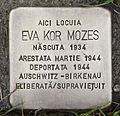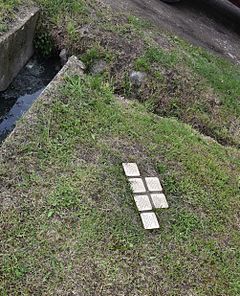List of stumbling blocks in Romania
The list of stumbling blocks in Romania contains the stumbling blocks in Romania , which remind of the fate of the people in this country who were murdered, deported, expelled or driven to suicide by the German National Socialists . The stumbling blocks were laid by Gunter Demnig .
Stumbling blocks are usually placed in front of the victim's last self-chosen place of residence. The laying in Romania took place in 2014. The Romanian name for Stolperstein is: piatra de care te împiedici .
Some of the tables can be sorted; the basic sorting is done alphabetically according to the family name.
Port
| Stumbling block | inscription | Location | Name, life |
|---|---|---|---|

|
HERE LIVED
ALEXANDER MOZES BORN 1900 ARRESTED March 1944 deported in 1944 AUSCHWITZ-Birkenau MURDERED May 1944 |
DC92 |
Alexander Mozes was born in 1900. He married Zseni-Jaffa Hersch in 1929. The couple had four daughters: Edit, Aliz and the twins Eva and Miriam. The family owned a piece of land and were farmers. They were the only Jews in the village. In 1940 the area came to Hungary as a result of the Second Vienna Arbitral Award , referred to by the Romanian side as the Vienna Diktat , and was occupied by troops of Hitler's ally Miklós Horthy . Alexander Mozes was a devout man. He made sure that his family obeyed the rules of religion.
In March 1944, the entire family was arrested and deported to the Șimleu Silvaniei ghetto in Sălaj County . A few weeks later they were transported to Auschwitz . At the ramp, the two twins were selected for human experiments in National Socialist concentration camps , the so-called Mengele's twin experiments . Alexander Mozes, his wife Zseni-Jaffa and his two older daughters Edit and Aliz went straight to the gas chambers and were murdered by the Nazi regime. |

|
ALIZ MOZES
LIVED HERE BORN 1931 ARRESTED MARCH 1944 DEPORTED 1944 AUSCHWITZ-BIRKENAU MURDERED MAY 1944 |
DC92 |
Aliz Mozes was born in 1931 to Alexander Mozes and Zseni-Jaffa Mozes Hersch. She had three sisters, an older one, Edit, and the younger twins, Eva and Miriam. In school and in the village she was exposed to a variety of discrimination. In March 1944, the entire family was arrested and deported to the Șimleu Silvaniei ghetto in Sălaj County . A few weeks later they were transported to Auschwitz . The family was separated at the ramp. Aliz, Edit and their parents were murdered in the gas chambers . The twins were chosen for Josef Mengele's experiments and barely survived the torture of the Nazis. |

|
HERE LIVED
EDIT MOZES BORN 1930 ARRESTED March 1944 deported in 1944 AUSCHWITZ-Birkenau MURDERED May 1944 |
DC92 |
Edit Mozes was the eldest daughter of Alexander Mozes and Zseni-Jaffa Mozes Hersch. She was born in Porț in 1930 and had three sisters, Aliz, born in 1931, and the twins Eva and Miriam, born in 1934. She was exposed to various forms of discrimination at school and in the village. In March 1944, the whole family was arrested and deported to the Șimleu Silvaniei ghetto in Sălaj County . A few weeks later they were transported to Auschwitz . The family was separated at the ramp. Eva and Miriam came to the Mengele's twin experiments department and were able to survive despite being mistreated. Edit, Aliz and their parents were murdered in the gas chambers . |

|
HERE LIVED
zseni-JAFFA MOZES HERSCH BORN 1906 ARRESTED March 1944 deported in 1944 AUSCHWITZ-Birkenau MURDERED May 1944 |
DC92 |
Zseni-Jaffa Mozes b. Hersch married Alexander Mozes in 1929 and had four daughters with him: Edit, Aliz and the twins Eva and Miriam. The family owned a piece of land and were farmers. Her husband was very religious. Zseni-Jaffa wanted to give her children a good education. Since the local school only had four classes, it hired a German private tutor, a Jew, who taught the children until 1944.
In March 1944, the entire family was arrested and deported to the Șimleu Silvaniei ghetto in Sălaj County . A few weeks later they were transported to Auschwitz . At the ramp, the two twins were selected for human experiments in National Socialist concentration camps , the so-called Mengele's twin experiments . Zseni-Jaffa Mozes, her husband Alexander and their two older daughters Edit and Aliz were taken straight to the gas chambers and were murdered by the Nazi regime. |

|
HERE LIVED
EVA KOR MOZES BORN 1934 ARRESTED March 1944 deported in 1944 AUSCHWITZ-Birkenau FREED / SURVIVE |
DC92 |
Eva Mozes Kor b. Eva Mozes was born with her twin sister Miriam on January 31, 1934 in Porț , Marca parish, Sălaj district. She was deported to Auschwitz with her three sisters and her parents in 1944. The parents and the two older sisters weremurderedin the gas chambers immediately upon arrival. Eva and Miriam were given to Josef Mengele for his cruel twin experiments . The two little girls survived and returned to Romania after the fall of the Nazi regime. In 1950 the twin sisters moved to Israel and served in the Israeli army . In 1960 Eva Mozes married the American Michael Kor, also a survivor of the concentration camps , and moved with him to Terre Haute in Indiana , where she still lives today.
She founded the Children of Auschwitz-Nazi's Deadly Lab Experiments Survivors ( CANDLES ) and was able to locate 122 survivors of the twin experiments . She struggled to clarify the background and consequences of the experiments - so that the victims can be adequately treated. In her book publications, she described her relationship with her father as difficult because he was very strict. But she also thought that this helped her later in Auschwitz. Her willingness to reconcile, documented for example in several appearances with Rainer Höß, the grandson of Auschwitz commandant Rudolf Höß , or as a joint plaintiff in the Auschwitz trial against Oskar Gröning , earned her substantial criticism from other Holocaust survivors. The filmmakers Bob Hercules and Cheri Pugh followed their work with the camera for several years, resulting in the film Forgiving Dr. Mengele came into being. |

|
HERE LIVED
MIRIAM HAND MOZES BORN 1934 ARRESTED March 1944 deported in 1944 AUSCHWITZ-Birkenau FREED / SURVIVE |
DC92 |
Miriam Mozes pointer was born together with her twin sister Eva on January 31, 1934. She was deported to Auschwitz with her three sisters and her parents in 1944 . The parents and the two older sisters were murdered in the gas chambers immediately upon arrival . Eva and Miriam were given to Josef Mengele for his cruel twin experiments . The sisters were separated for two weeks. Miriam was under constant surveillance by Nazi thugs while Eva received injections. The sisters later found out that if Eva had died from the injections, Miriam would have been killed immediately. Then both bodies would have been autopsied for comparative studies. In the months to come, Miriam fell ill with dysentery and kidney inflammation as a result of the injections she was given. But the two little girls barely survived. When the Red Army approached Auschwitz, most of the concentration camp inmates were sent on so-called death marches . Only the elderly, the sick and children remained. On January 27, 1945 Eva and Miriam were liberated by the Soviets. They came to rest in a monastery in Katowice and then returned to Romania under the care of Mrs. Csengeri. In 1950 the twin sisters moved to Israel and served in the Israeli army .
Miriam trained as a nurse, married Yekutiel Zeiger and gave birth to three children, Yaffa, Ariella and Ayala. She had a total of ten grandchildren. Throughout her life she had to struggle with kidney problems due to the experiments in the concentration camp. In 1987 Eva donated a kidney to her, but eventually she got cancer and died on June 6, 1993. |
Timișoara
| Stumbling block | inscription | Location | Name, life |
|---|---|---|---|

|
BLOCH LORAND JG LIVED HERE . 1909 LABOR CAMP FO 1941 NEAR PĂULIS TOT 11/12/1943 |
Piața Romanilor 8 |
Lorand Bloch was born in 1909 and was deported to a labor camp in Păuliș in 1941. There he was killed in an accident on November 14, 1943. The first stumbling block in Romania was dedicated to him. |
Laying data
The Stolpersteine were laid by Gunter Demnig personally on the following days:
swell
- Stolpersteine.eu , Demnig's website
literature
- Eva Mozes Kor, Mary Wright: Echoes from Auschwitz. Dr. Mengele's Twins. The Story of Eva & Miriam Mozes , Terre Haute 1995, ISBN 0964380757
- Eva Mozes Kor and Lisa Rojany Buccieri: I survived the angel of death: a Mengele victim told , Munich: cbj 2012, ISBN 978-3-570-40109-5 .
- Eva Mozes Kor, Guido Eckert: The Power of Forgiveness , Benevento 2016, ISBN 978-3710900112
Web links
Individual evidence
- ^ The stores of Rainer Höß on welt.de from May 5, 2012
- ↑ Groening had admitted moral complicity on the first day of the negotiation, showed remorse and asked for forgiveness. The negotiation observer Beate Klarsfeld described his request for forgiveness as exceptional for a Nazi trial: Beate Klarsfeld about Groening's confession on wdr.de. Eva Moses Kor held out her hand to the accused as a gesture of reconciliation. She thanked him expressly because he did not refuse to testify and did not deny the Holocaust, but described it.
- ↑ Roman Heflik: A Holocaust Survivor's Path to Peace - Forgiving Josef Mengele, Spiegel-Online, December 9, 2005 , accessed on June 17, 2018
- ↑ USC Shoah Foundation , The Institute for Visual History and Education: Miriam Mozes Zeiger , January 21, 2015, accessed December 9, 2016

